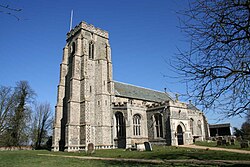Cockfield, Suffolk
| Cockfield | |
| Suffolk | |
|---|---|
 St Peter's Church | |
| Location | |
| Grid reference: | TL905546 |
| Location: | 52°9’25"N, 0°47’2"E |
| Data | |
| Population: | 868 (2011) |
| Post town: | Bury St Edmunds |
| Postcode: | IP30 |
| Dialling code: | 01284 |
| Local Government | |
| Council: | Babergh |
| Parliamentary constituency: |
South Suffolk |
Cockfield is a village and parish located approximately 3½ miles from Lavenham in the Babergh hundred of Suffolk. The village consists of a central point and several outlying hamlets: Buttons Green, Colchester Green, Cross Green, Great Green, Oldhall Green, Smithwood Green and Windsor Green. Surrounded mostly by fields used for farming, and with few roads, its population was 839 in 2001, increasing to 868 at the 2011 Census.[1]
The village previously had a railway station on the Long Melford-Bury St Edmunds branch line, but it was closed in 1961. Its football team, Cockfield United play in the Suffolk and Ipswich Football League.
History
The present village has been inhabited for well over 2000 years. The finding of a sword (now in the Moyse Hall Museum in Bury St Edmunds) is evidence of Bronze Age settlement, and a number of findings indicate ancient defensive ditches, known as The Warbanks.
The village's present name is derived from "Cochan-feld" probably indicating a site established by a person named Cochan. The village appeared in the Domesday Book of 1086 under the name of "Cothefelda" and is listed as a prosperous manor whose wealth had grown since the Norman Conquest. During the Middle Ages, the village became "Cokefield" and finally "Cockfield".
Cockfield became a centre a Puritanism during the 17th century. During the 19th century the parish was one of the largest and wealthiest in Suffolk and the seat of a number of prestigious rectors.[2]
St Peter's Church
A landmark visible for a distance across the neighbouring countryside, the church of St Peter's is one of the finest of Suffolk's many village churches, with the present building mostly dating from the 14th and 15th centuries. The church's size is unusual for such a rural location, but this becomes less surprising when one considers its location between the three great mediæeval merchant towns of Bury St Edmunds, Lavenham, and Sudbury.
There is no record of a church in the Domesday Book although a village of Cockfield's size would almost certainly have had one. The first surviving record of the parish's ecclesiastical history dates from 1190 when William de Cullum was installed as the first rector, although there is no existing record of the site prior to the building of the present church in the 14th century.[3]
The church fell under the patronage of the Abbot of St Edmundsbury until the Reformation when the Spring family, wealthy Lavenham clothiers and noblemen, took over, resulting in a close link with the region's strong wool trade. From 1708 the patronage fell to St John's College, Cambridge who appointed a number of distinguished Fellows of the College. Rectors of St Peter's have included John Knewstub the Presbyterian, William Ludlam the mathematician, and Churchill Babington the archaeologist and botanist. In May 1582, an assembly of about 60 clergymen from Norfolk, Suffolk, and Cambridgeshire met in Cockfield Church to confer about the Prayer Book, clerical dress, and customs.[4]
The church's sizeable square flint tower dates from the 14th century and is buttressed almost to the top. The tower was nearly destroyed by a storm during the winter of 1774-5 and on August 2, 1775, after repairs were nearly completed, an apparent lightning strike resulted in a fire that damaged it once again. The mathematician William Ludlam, rector from 1767, installed an astronomical observatory on the tower whose filled in windows can still be seen.[2]
The village school
In the same road as the church is the village school, serving the village and surrounding communities. Children from the ages of four to nine attend the school. Find more information at the school website.
Notable residents
- John Spring (d. 1547), merchant and landowner.
- John Knewstub (1544–1624), clergyman and one of the participants in the Hampton Court Conference of 1604 representing the Puritan side.
- William Manning (c. 1630–1711), ejected minister and Unitarian writer.
- William Ludlam (1717–1788), clergyman and mathematician, rector of Cockfield.
- Churchill Babington (1821-1889), classical scholar, archaeologist and naturalist
- Norah Burke (1907-1976), novelist and travel writer.
References
- ↑ "Parish population 2011". http://www.neighbourhood.statistics.gov.uk/dissemination/LeadKeyFigures.do?a=7&b=11122144&c=IP30+0BE&d=16&e=62&g=6465659&i=1001x1003x1032x1004&m=0&r=0&s=1442147647234&enc=1.
- ↑ 2.0 2.1 D. P. Mortlock. The Popular Guide.
- ↑ Betty Barratt, Gillian Hodge (2003). St Peter's Church, Cockfield. Cockfield Parochial Church Council.
- ↑ Collinson, Patrick. (1990). The Elizabethan Puritan movement. Oxford: Clarendon Press. ISBN 0-19-822298-X. OCLC 20320262. https://www.worldcat.org/oclc/20320262.
| ("Wikimedia Commons" has material about Cockfield, Suffolk) |